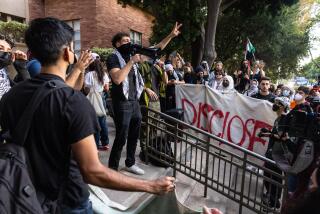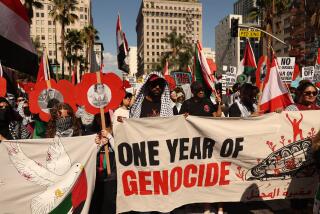Tradition of Dissent Unleashed in San Francisco : Protests: The city has been home to the nation’s largest anti-war demonstrations. Crowds have blocked the Golden Gate and Bay bridges.
SAN FRANCISCO — Tens of thousands of noisy demonstrators have coursed through San Francisco like an angry river of dissent this week, transforming its streets into the nation’s most visible center of resistance to the Persian Gulf War.
The crowds have blocked both the Golden Gate and San Francisco Bay bridges seemingly at will, disrupted work at the federal building, torched a Highway Patrol car and drenched large parts of downtown with vituperative graffiti.
San Francisco Mayor Art Agnos has felt compelled to reassure city residents that the demonstrations aren’t out of control, but they have been sufficiently big, disruptive and persistent to establish San Francisco as Resistance City, U.S.A.
The reasons for this are many, political scientists and others believe.
“This is a place where the networks of radicalism and alienation have been fully developed for 50 years,” said Todd A. Gitlin, a professor of sociology at UC Berkeley.
San Francisco, created overnight by the Gold Rush in 1849, has long been a haven for rootless free-thinkers. Gitlin said this explains the city’s embrace of labor activists in the 1930s, anti-war workers in the ‘60s and gay-rights advocates in the ‘70s.
“It’s an area with continuing political awareness and continuing political activism,” said James Newton, an associate professor of psychology at San Francisco State University, “so attention can be turned to new events in a new part of the world without having to start from scratch. They already know other people and groups of similar beliefs.”
Current protests rank with the biggest in city history. Although militants have failed to raise interest in a general strike similar to the one that longshoremen used to close the city in 1934, the 991 people arrested Thursday exceeded the number for any single day of unrest in the Vietnam War.
People active in domestic political issues--and there are many in the city--have been quick to join the anti-war movement because they believe the war is a needless diversion of attention and resources from their causes.
ACT UP--the AIDS Coalition to Unleash Power--and a radical gay-rights group called Queer Nation both played a key role in peace marches that closed the Bay Bridge three days in a row. Greenpeace, the militant environmental group, also helped support the actions.
“People active in AIDS or environmental movements, they see the country, with a huge deficit, now spending billions of dollars on a military adventure reacting to a problem we helped to create in the first place,” Newton said.
“It is frustrating for them to think that all the resources they struggled to get are teensy compared to what is being spent on this (war).”
For a small fraction of people who have taken to the streets, frustration has boiled into violence. During a march by 10,000 people Wednesday, windows were broken, military recruiting offices were sacked and bottles rained down on San Francisco police.
The majority of demonstrators, content to chant and march with signs, have tried unsuccessfully to discourage troublemakers.
Mayor Agnos, who sympathizes with demonstrators, has said his tolerance will not extend to attacks on people or property.
“Violence against police officers or citizens is not acceptable,” he said Wednesday. “The success of peace demonstrations will depend on how peaceful they are, not how violent or disruptive they could become.”
Agnos has warned that the costs of policing the demonstrations and cleaning up large amounts of graffiti and other vandalism will strain the city’s budget and may lead to reductions in social services.
San Francisco police, with a few exceptions, have been restrained in handling the crowds. Outnumbered, outflanked and often taunted, spit at and targeted by radicals hurling epithets, fireworks and bottles, they have not tried to stop protesters from expressing their views. Encouraged by Agnos, they have let marchers roam just about wherever they want.
By working with the protesters, police have so far been able to avoid the most violent kinds of confrontations. When a crowd turned ugly late Thursday evening, for example, police decided to talk instead of fight.
“Will the leaders of the march please come to the front?” police pleaded via bullhorn at the intersection of Haight and Ashbury streets. “We will make a deal with you if you will continue a peaceful march.”
The real test may come today, however, when San Francisco hosts the West Coast counterpart of a mass demonstration scheduled for Washington. Organizers here expect that as many as 20,000 people could attend.
Police, in anticipation, have summoned an extra 55 California Highway Patrol officers from Southern California to help keep the demonstrators off the bridges.
More to Read
Sign up for Essential California
The most important California stories and recommendations in your inbox every morning.
You may occasionally receive promotional content from the Los Angeles Times.










